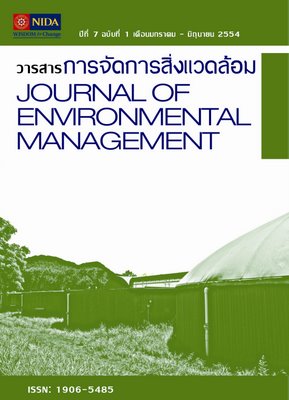แนวทางการจัดการขยะให้เหลือศูนย์ภายในมหาวิทยาลัยมหิดล ศาลายา Zero Waste Mangement in Mahidol University Salaya Campus
บทคัดย่อ
บท ความวิจัยนี้เป็นการศึกษาปริมาณ องค์ประกอบ และลักษณะสมบัติของขยะที่เกิดขึ้นภายในมหาวิทยาลัยมหิดล ศาลายา พร้อมทั้งนำเสนอแนวทางการจัดการขยะให้เหลือศูนย์ โดยรวบรวมข้อมูล ได้แก่ ปริมาณ อัตราการเกิด องค์ประกอบ ลักษณะสมบัติทางกายภาพและเคมีของขยะ และนำมาวิเคราะห์แนวทางการจัดการขยะให้เหลือศูนย์ การศึกษาข้อมูลในปี พ.ศ. 2551 พบว่า ปริมาณขยะที่นำไปกำจัดเฉลี่ย 4,060 กิโลกรัม/วัน อัตราการผลิตขยะเฉลี่ย 0.303 กิโลกรัม/คน/วัน ผลการวิเคราะห์องค์ประกอบขยะ พบว่ามีพลาสติกเป็นองค์ประกอบสูงสุด ร้อยละ 39.88 ขยะเศษอาหาร ร้อยละ 28.66 และ กระดาษร้อยละ 14.95 ผลการวิเคราะห์ลักษณะสมบัติของขยะพบว่า ค่าความหนาแน่นของขยะ 0.056 kg/l ค่าความชื้น ร้อยละ 59.74 ปริมาณของแข็งทั้งหมด ร้อยละ 40.26 ปริมาณสารที่เผาไหม้ได้ ร้อยละ 88.12 ปริมาณเถ้า ร้อยละ 11.88 และค่าความร้อน 4,915 cal/g การจัดการขยะของมหาวิทยาลัยมหิดลศาลายา ปัจจุบันยังคงมีปัญหาที่ต้องปรับปรุงในด้านการเก็บรวบรวม การคัดแยก การรีไซเคิลขยะ แนวทางในการจัดการขยะให้เหลือศูนย์ เริ่มจากการกำหนดนโยบายสิ่งแวดล้อม ร่วมกับการรณรงค์เพื่อสร้างความตระหนักแก่นักศึกษาและบุคลากรในการลดการผลิต ขยะ ตัวอย่างกิจกรรมการจัดการขยะ ได้แก่ การคัดแยกขยะ ธนาคารขยะรีไซเคิล การทำปุ๋ยหมัก และการผลิตก๊าซชีวภาพจากขยะเศษอาหาร
The objective of this study is to determine solid waste generation rate, waste composition and their physical and chemical properties, and to propose a zero waste management program for Mahidol University, Salaya Campus. The study relied on primary data, including waste sources, existing waste management practice and waste generation rate in 2008 to analyze waste composition, physical and chemical properties using ASTM standard methods. The result of the study showed that Mahidol University produced 4,060 kg/day of solid waste, which accounts to the waste generation rate of 0.303 kg/person/day. The composition analysis revealed that plastic represents the largest portion in the waste stream (39.88%), followed by food waste (28.66%) and paper (14.95%). Regarding physical and chemical properties, solid waste from Salaya Campus had a bulk density of 0.056 kg/l, and contained 59.74 % of moisture, 40.26% of total solids, 88.12% of combustible content and 11.88% of ash. This waste has a calorific value of 4,915 cal/g. The institutional waste management program has encountered several problems in waste collection, separation and recycling. In response to the problems, this study proposed a waste management program that aimed at facilitating discussion among academic and local authority staff, as well as raising public concern over waste recovery, reduction and recycling. The proposed program activities include, for example, solid waste separation, recyclable waste bank, yard waste composting and biogas production.


